As with all my reviews, this is a totally subjective personal view and not an in-depth technical analysis. For more mainstream reviews, check out Engadet, Pocket Lint, Expert Reviews, and Casey Johnston’s Air vs Pro comparison on Arstechnica if you’re also considering an Air.
My old faithful Dell E4300 has done its dash. Actually it still works; it runs Ubuntu well, it has an SSD and 4GB of ram which makes it pretty nippy for web browsing and lightweight tasks, but what sealed its fate was my work laptop – a 15″ Retina Macbook Pro. After getting used to that gorgeous 2880×1800 screen, I found I just couldn’t go back to the Dell any more with its 1280×800 TN LCD (ugh), horrible touchpad and 2009-era performance.
Also, technology has moved on. When the E4300 was new, 5 hours of light-use battery life was very good, but today it’s unacceptable. Graphics performance has also come a long way, although perhaps not as far as we’d like.
The 5 years I had from the Dell though is a good run, and I seriously considered getting another Latitude. But if I went with a Latitude, I’d have ended up with another Dell laptop of roughly the same dimensions, that supported only Windows (meaning, you’re on your own if you have trouble with Linux), an inferior display, and battery life well behind the state of the art. To make things worse it would also be more expensive. A Latitude would however be repairable, which is what kept the E4300 going so long.
So I started shopping around for a new laptop, and eventually settled on a 13″ Retina Macbook Pro. I doubt the Mac will last 5 years, but it also won’t need many of the upgrades the Dell did – it already has bluetooth, an SSD, USB3 and thunderbolt. So as long as 8gb of ram remains adequate, non-upgradeability shouldn’t be too much of a down side.
Hello
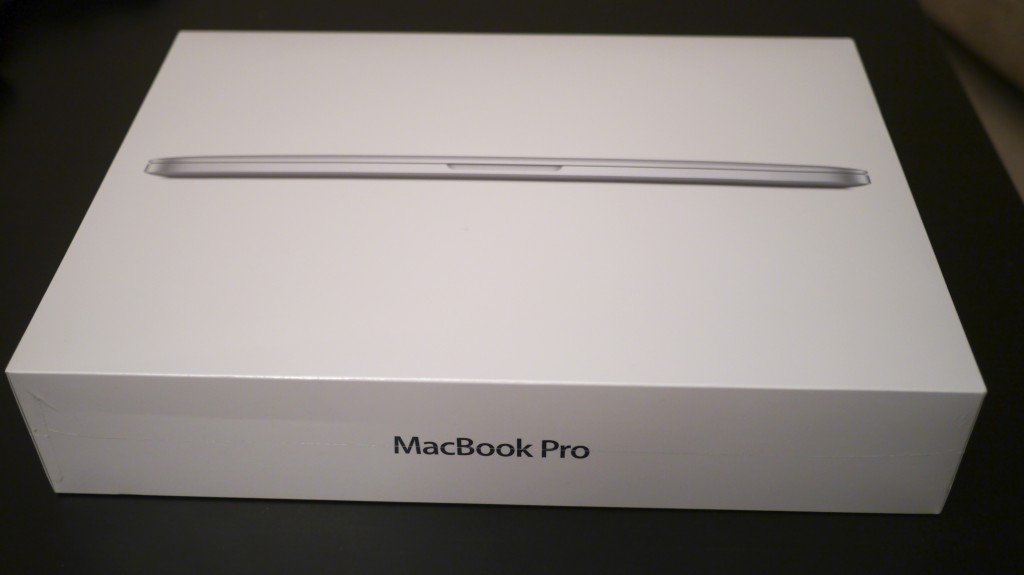
Rather than order via the Apple store, I opted for the top spec base model via eBay seller baffztronics. If you go for one of the standard configurations it’s easy to find it cheaper than the Apple store, but if you want to customise, Apple is your only option. In my case, I paid £1275 for a configuration that costs £1499 on the Apple Store, which is a decent saving. This model is ME866B/A – Core i5 2.6ghz, 8gb ram, and 512gb SSD. If I had purchased from the Apple store, I would have gone for the 2.4ghz model with 8gb ram and 256gb SSD, which at the time of writing costs £1250.
The packaging, as you’d hope, was very good from this seller. The box you see above shipped within another larger box, with thick cardboard corners holding it firmly in place.
First Impressions
It’s a Mac. What have I done.
Display
The screen size is (obviously) about the same physical size as my Dell, but oh the detail. Coming from a TN LCD panel of any kind, the retina display, or any modern high-end IPS display really, will be a revelation. Colours are accurate, contrast is fantastic, brightness is good if not amazing (adequate in all but bright sunlight, which we lack in the UK anyway), blacks are as deep as any LCD I’ve seen, and the backlight is very even.
Also the viewing angles are outstanding. The image below demonstrates the difference to the Latitude – the TFT panel on the Dell has lost all colour and contrast, whereas the retina display seems to have lost none at all, despite the sharp angle:
Honestly I can’t find any fault, this display will keep me happy for a long time, and is by far the largest reason to go for the Pro over the Air. The downside, even compared to the air, is repairability – the glass is fused to the display, potentially making repairs more expensive. And of course driving all those pixels must negatively impact battery life.
Keyboard
Apple’s keyboards are a little controversial but at least they’re consistent.
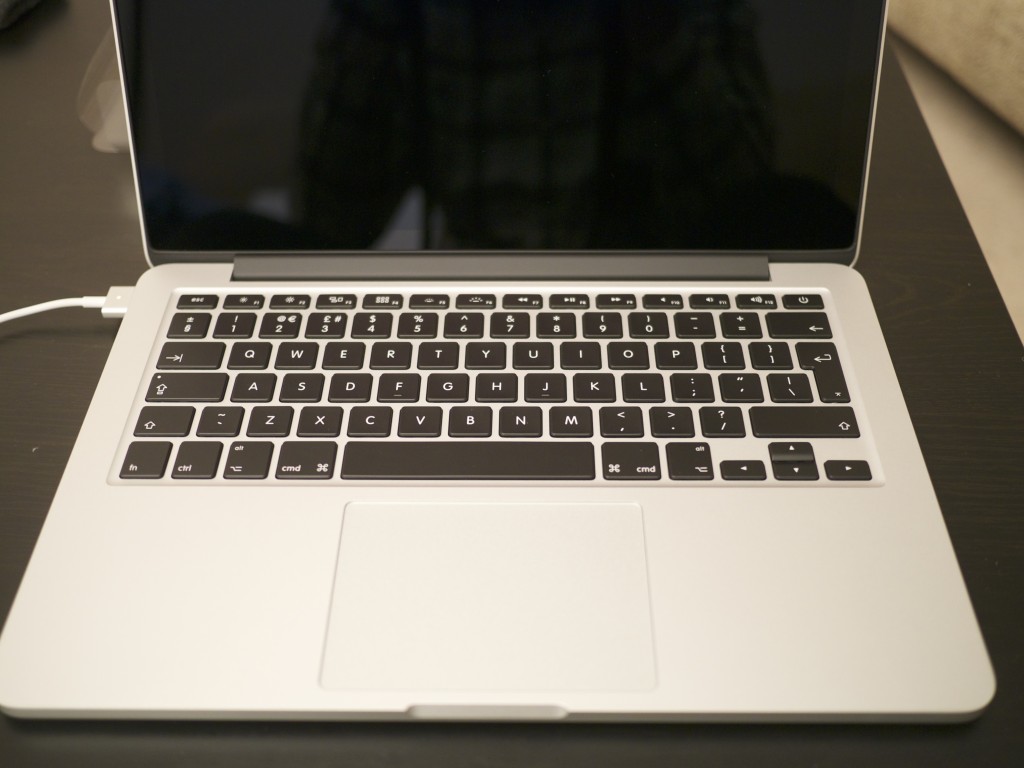
Of particular annoyance is the # key situation. The UK and many other non-US layouts have a dedicated # key next to return, and US layouts have this on the number 3, accessible with shift. So far, no problem. Apple places the pound sign (£) on Shift+3, like the standard UK layout does, but instead of including a dedicated # key, it relegates the # to Alt+3.
This isn’t a problem for many uses, but if you’re a software developer and your language uses # to comment lines, it’s a serious pain in the ass to fumble Alt+3 all the time, especially when you’re used to having a dedicated key for it. The quick and dirty solution to this is to switch to the US layout and figure out another shortcut for £, but this probably won’t be an acceptable solution for many.
On the subject of feel, if you’re used to Dell or Lenovo business laptop keyboards, which are generally pretty good, the chiclet keys can take a bit of getting used to. I like it now, but it has taken a while, and I still prefer normal non-chiclet keyboards without gaps between the keys. And tellingly, I’m faster on the Dell. This is a matter of personal preference though.
The travel and feel is fine if not superb, and other than the # situation the layout has no surprises (Lenovo could learn a thing or two here). I do miss home, end, and pgup/pgdn however, the latter of which the Latitude places conveniently by the arrow keys.
And of course the keyboard backlight is great, but so is Dell’s. Snooze.
Trackpad
The Macbook trackpads are simply the best there is. I’m probably not an expert on the subject as I’m coming from the E4300’s which is appalling (the pointer nub was a life saver), but the Macbook trackpad is large, smooth, accurate and free of lag, none of which I can say of the Latitude’s. Like almost all modern trackpads it also supports multi-touch, and the gestures it supports are rather handy:
I especially like the 4-finger gestures: swiping 4 up will open expose for all open apps, 4 down opens expose for the currently focused app, the 4 sideways will switch between desktops and any apps using OSX native full-screen mode. It makes multitasking a breeze.
CPU Performance
It boots in seconds, and hasn’t kept me waiting once. What more can I say. The fact that the Core2 Duo in the E4300 was still adequate for 90% of my computing time means the Haswell i5 will perform well for quite some time. But I stopped editing photos on the Dell long ago, and I can now do this on the Macbook comfortably.
GPU Performance
What’s more interesting is the graphics performance. I can honestly say I was pleasantly surprised here, the Intel Iris GPU is barely distinguishable from the Geforce 650M in the older 15 inch retina.
I tested it out with Batman: Arkham City and had smooth gameplay at 1440×900 with high details and no AA. That’s pretty impressive, but it still doesn’t really make a portable gaming machine, as playing most Steam games on battery will cause it to choke and die within a couple of hours. The energy cost of gaming is not something unique to laptops, but PC games are worse as they all but assume you’re running off mains.
Civilisation V will only let me run in 1280×800 or 2560×1600 (High DPI mode). 1280×800 obviously doesn’t look brilliant so I tried High DPI mode expecting a slide show but was pleasantly surprised. The start of the game was perfectly playable, even zooming out, but I suspect this will slow down as the action heats up. I purchased Civ5 on Steam, and the Steam overlays clearly aren’t Retina-ready, as they look positively tiny in High DPI mode!
VS the 15 inch Retina (early 2013)
In short – smaller screen, better battery life, lower CPU performance (dual vs quad-core), and of course lower price. The DPI is slightly higher on the 13 but you couldn’t tell without a microscope.
VS my old faithful Dell
This comparison is a bit of a joke, Apple has 6 years advantage here. Still, it’s nice to illustrate how technology has progressed. The E4300 might not have been the slimmest of its kind, but it wasn’t considered chunky by any means.
You can already see the difference in thickness here – despite having the same size screen the Latitude is almost as tall as the retina 15 when opened. Also note the massive difference in touchpad surface area.
Side on, I’d say that the retina with its lid shut is slimmer than the Dell without its screen:
And then there’s 54000 mAH battery sticking out the back (now down to about 30000 mAH but at least I could replace it if I wanted to). Apple has somehow managed to fit a battery of even greater capacity inside.
Value
Prior to Intel’s Ultrabook initiative, this level of portability in a PC laptop would have cost a fortune, and significant sacrifices to performance and battery life would have had to be made. This Macbook represents an incredible balance of performance and portability – it’s all the computing power many people will ever need, and it can do it all day on battery if you don’t tax it too much. It’s hard not to be impressed.
I give Intel too much credit though. While they produce the processors it was Apple that really started it all off with its supply-chain changes that launched with the first unibody Macbook Pros in 2008. Until recently, nothing came close to the Macbook Airs, they represented outstanding value compared to what else was out there, and they were slimmer and better built than anything else. The whole Ultrabook initiative was Intel telling PC manufacturers that they needed to catch up to Apple, and to some degree, they have.
Dell’s XPS, Acer’s S7 and Lenovo’s Yogas are all competitive, and Lenovo’s X1 looks outstanding, weird keyboard aside (honestly, what were they thinking). But for me, the Retina Macbook still represents the best balance of performance, price and portability. If not the best 13″ notebook it’s pretty darn close, and while you would never call it cheap, it’s nowhere near the most expensive.
You can get an Ultrabook for half the cost of a Retina Macbook, but performance, battery life, display, trackpad and build quality all suffer in very meaningful ways. For me, a laptop is something I use every day, and I feel it’s worth getting something I want to use.
Conclusion
It probably isn’t going to last as my primary personal machine for 5 years like the Latitude did, but arguably the Latitude shouldn’t have lasted that long anyway. This Macbook is the nicest laptop I’ve used by a large margin (Retina 15 excepted).
The only fly in the ointment is that I know I’m going to be envying the mid-2014 Macbook Air when it’s released. It’s rumoured to be getting a display upgrade, and with that it might just be my perfect notebook. It will be interesting to see if it maintains the stellar battery life of the current model.

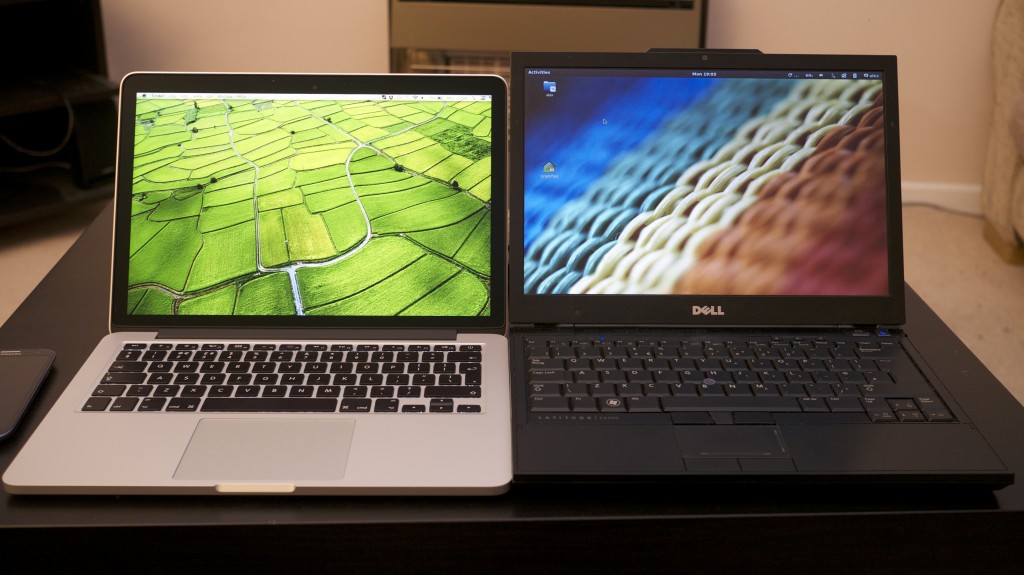

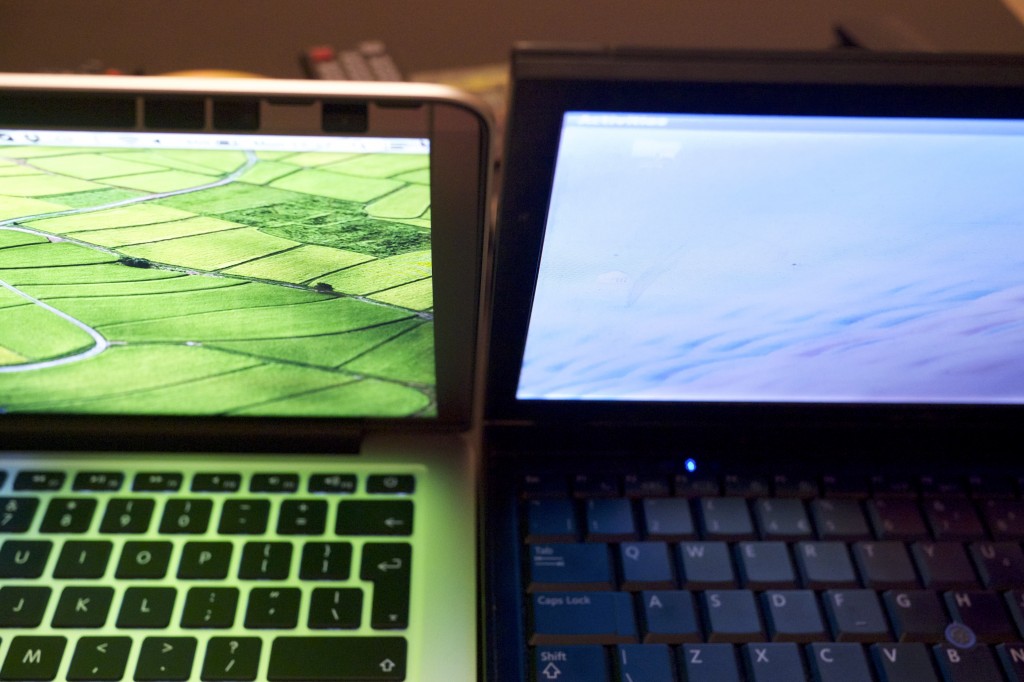
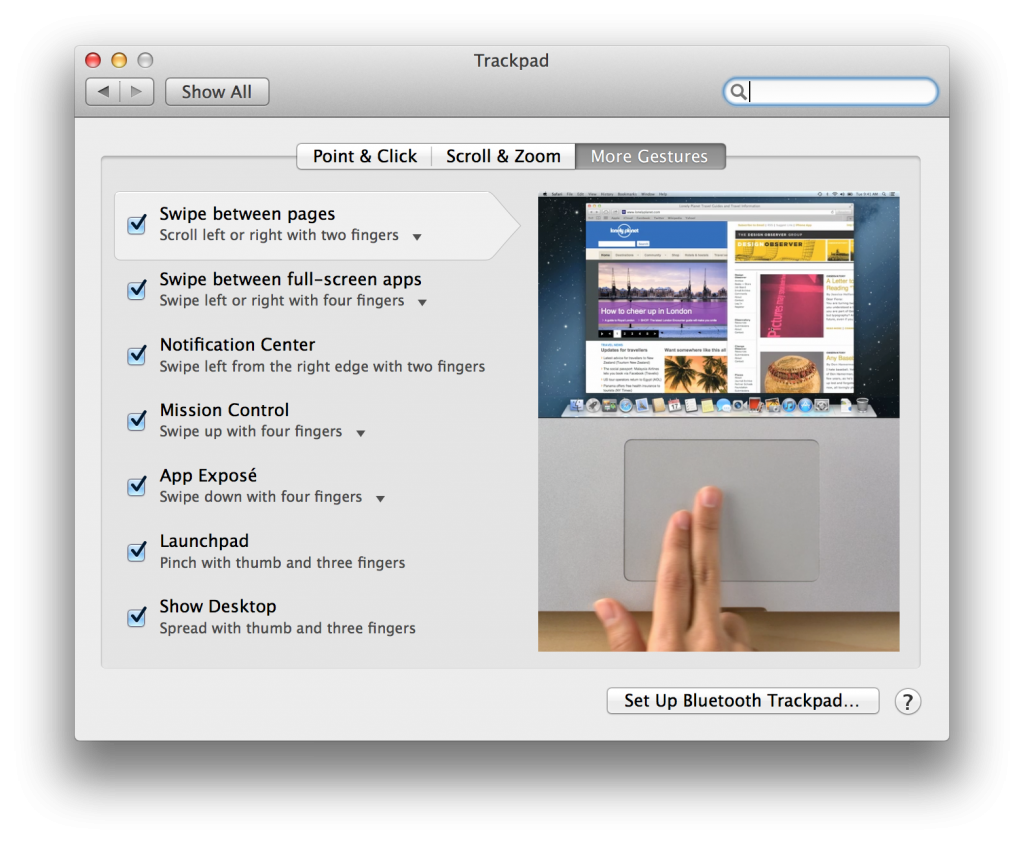
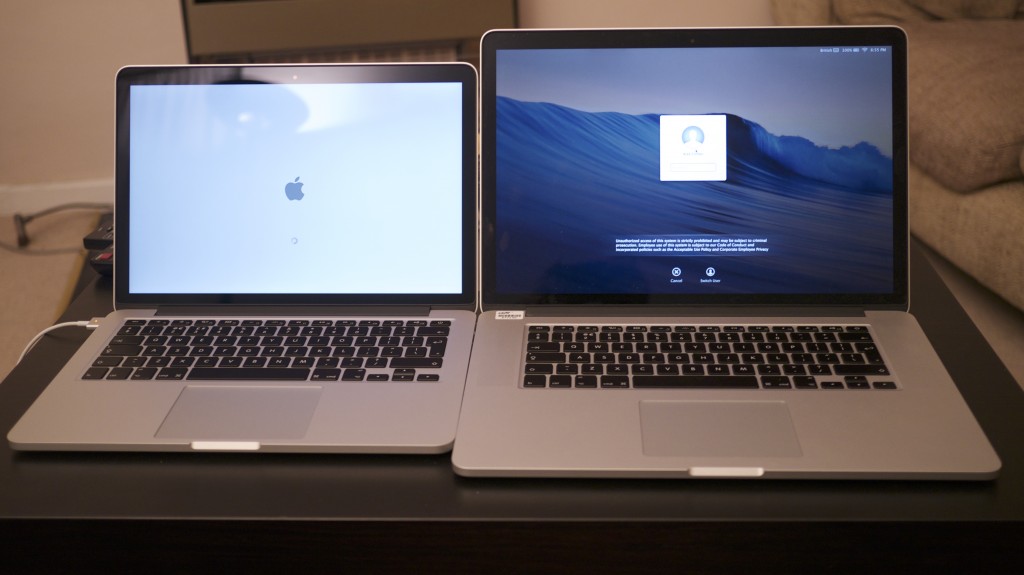

Pingback: Laptop upgrade 2020 – back to a Dell Latitude | Al4